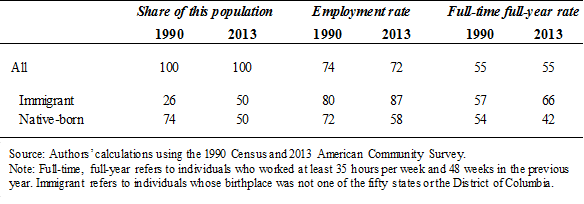Education counts for more and more in the labor market, as a recent Hamilton Project paper on prime-age workers confirms. Individuals without a bachelor’s degree have become less likely to work—especially full-time and year-round—and those who do work are more likely to be in lower-paying occupations.
The share of men with a high school degree or some college (but not a BA) who worked full-time and year-round fell from 76 percent in 1990 to 68 percent in 2013. Interestingly, for men without a high school degree, the share was low but unchanged, at 55 percent. Why did men without a high school degree not experience the same declines in full-time year-round employment?
High school dropouts are not created equal: Men
It turns out that overall employment rates for men without a high school degree mask important differences between immigrants and native-born individuals. Immigrants now account for a much larger share of men without a high school degree, doubling from about one-quarter to one-half between 1990 and 2013.
Table 1. Employment Trends for Native-Born and Immigrant Men Age 30–45 Without a High School Degree, 1990–2013
US-born men without a high school degree have seen a dramatic reduction in their employment rate—from 72 to 58 percent. The fall was also dramatic for the share working full-time and year-round, sliding from 54 to 42 percent.
In sharp contrast, the employment rate of immigrant men without a high school degree rose from 80 to 87 percent, and the share working full-time and year-round rose from 57 to 66 percent.
These diverging trends effectively offset each other, resulting in a stable overall employment rate:
High school dropouts are not created equal: Women
The story is quite similar for women without a high school degree:
Table 2. Employment Trends for Native-Born and Immigrant Women Age 30–45 Without a High School Degree, 1990–2013
Native-born women who lack a high school degree have seen sharp drops in their employment rates—both overall and full-time, full-year. By contrast, immigrant women’s employment and full-time full-year rates have held steady.
Why are less-educated immigrants more likely than US-born peers to work?
In 1990, immigrants and the native-born without a high school degree had similar employment rates. By 2013, immigrants were substantially more likely to be working. What explains these different trajectories? There are few significant differences in the kind of work undertaken by immigrants and the native-born. But there has been a notable shift in the country of origin of immigrants without a high school degree and we find that this explains part, but not most, of the employment story. For immigrant men, the changing composition of origin countries can account for about half of the increase in the overall employment rate and only about one-quarter of the increase in the full-time, full-year rate.
The full range of potential causes of these diverging paths is long and complex, but likely includes the rapid pace of technological change, trade and globalization, and the growing generosity (relative to possible earnings) of safety-net programs such as disability insurance. One thing is clear, however. As well as examining the divide between groups with different levels of education, we must pay attention to the distinct experiences of US-born and immigrant Americans.






Commentary
Need a high school diploma to work full-time? Natives, yes. Immigrants, no.
May 12, 2015